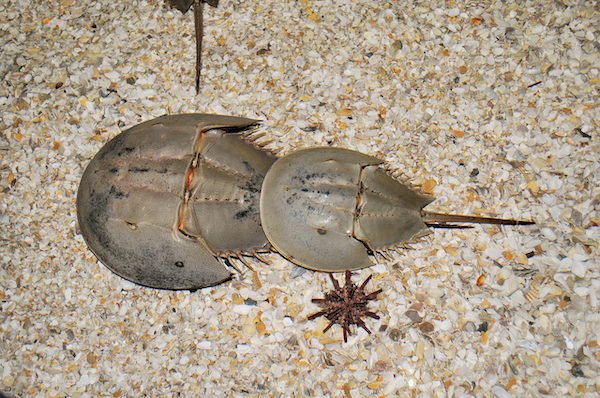| Crustaeceans and Marine Arthropods |
| Horsehoe Crab |
| Christmas Island Crab |
| Coconut Crab |
| Hermit Crab |
| Fiddler Crab |
| Alaskan King Crab |
| American Lobster |
| Rusty Crayfish |
 |
Horseshoe crabs, often referred to as "living fossils," are marine arthropods that have been traversing the world's oceans for over 450 million years. Despite their name, horseshoe crabs are not true crabs; they belong to the arachnid family, making them more closely related to spiders and scorpions.
Anatomy and Physical Features: The Marvels of Horseshoe Crab Physiology
Horseshoe crabs are renowned for their distinctive horseshoe-shaped carapace, which protects their body and provides a sturdy shield against predators. Their long, pointed tail, often mistaken for a stinger, is used for steering and righting themselves when flipped. Beneath their armor, horseshoe crabs boast an array of specialized adaptations, including compound eyes for enhanced vision, gill-like book gills for breathing, and copper-based blue blood that plays a crucial role in medical science.
Mating Rituals and the Ancient Dance: The Spectacle of Horseshoe Crab Breeding
Every spring, along the Atlantic Coast, horseshoe crabs engage in a mesmerizing spectacle of mass mating known as the "ancient dance." Under the glow of the moon, female horseshoe crabs emerge from the depths to lay their eggs in the sandy shores, while males eagerly await to fertilize them. This synchronized dance, a testament to the survival instincts developed over millions of years, is not only crucial for the continuation of horseshoe crab populations but also plays a vital role in the ecosystem.
Medical Marvels: Horseshoe Crabs and the Blue Blood Revolution
Horseshoe crabs have inadvertently become unsung heroes of modern medicine due to a unique substance in their blood known as Limulus amebocyte lysate (LAL). LAL is highly sensitive to bacterial endotoxins, making it an invaluable tool for testing the sterility of medical equipment, vaccines, and intravenous drugs. The harvesting of horseshoe crab blood, done with care to preserve the creatures, has revolutionized the safety of medical products worldwide.
Conservation Challenges: Balancing the Scales for Horseshoe Crab Populations
Despite their resilience, horseshoe crab populations face several threats, including habitat loss, overharvesting for bait in the eel and conch fisheries, and climate change affecting nesting sites. Efforts to conserve horseshoe crabs involve a delicate balance between human activities and preserving the ecological roles these ancient creatures play in the intricate web of marine ecosystems.